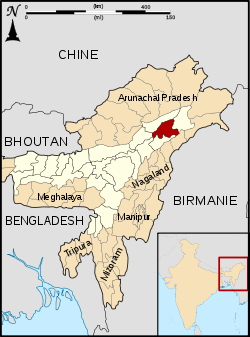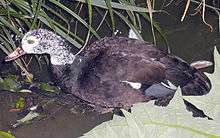Dibrugarh district
Dibrugarh (Pron:ˌdɪbru:ˈgor:) is an administrative district in the state of Assam in India. The district headquarters are located at Dibrugarh city. The district occupies an area of 3381 km².
Dib district | |
|---|---|
District of Assam | |
 Location of Dib district in Assam | |
| Country | India |
| State | Assam |
| Division | Dibrugarh Division |
| Headquarters | Dibrugarh |
| Tehsils | 1. Dibrugarh City 2. Moderkhat 3. Lahowal 4. Rohmoria 5. Laruwa 6. Jamira 7. Mancotta-Khanikar 8. Moran 9. Sepon 10. Lengeri 11. Khowang 12. Tengakhat 13. Tipling 14. Kheremia 15. Chabua Pulunga 16. Bogdung 17. Gharbandi 18. Sasoni 19. Joypur 20. Fakial 21. Tingkhong |
| Government | |
| • Lok Sabha constituencies | 1. Dibrugarh |
| • Vidhan Sabha constituencies | 1. Moran 2. Dibrugarh 3. Lahowal 4. Duliajan 5. Tingkhong 6. Chabua 7. Naharkatia |
| Area | |
| • Total | 3,381 km2 (1,305 sq mi) |
| Population (2011) | |
| • Total | 1,326,335 |
| • Density | 390/km2 (1,000/sq mi) |
| Demographics | |
| • Literacy | 76.22% |
| • Sex ratio | 952 per 1000 male |
| Time zone | UTC+05:30 (IST) |
| Major highways | NH-37 |
| Website | dibrugarh |
Etymology
Dibrugarh derived its name from Dibarumukh (as a renowned encampment of Ahoms during the Ahom-Chutia war). Either the name "Dibru" evolved from Dibaru river or from the Bodo-Kachari word "Dibru" which means a "blister" and "Garh" meaning "fort". Both "Dibru" and "Dibaru" are Bodo-Kachari words. The Bodo-Kacharis add the prefix "Di-" (which means "water") wherever there is small stream, a river, or a large river in a town or city.[1]
History
Dibarumukh was a renowned encampment of Ahoms during Ahom-Chutia conflict. It was part of the Chutia kingdom until 1523 A.D. After the defeat of the Chutias, the Ahom king placed an official named as Chaolung Shulung to control the region.[2] Dibrugarh became a separate district when it was split from Lakhimpur on 2 October 1971.[3] On 1 October 1989 Tinsukia district was split from Dibrugarh.[3]
Geography
Dibrugarh district occupies an area of 3,381 square kilometres (1,305 sq mi),[4] comparatively equivalent to Russia's Vaygach Island.[5] The district extends from 27° 5' 38" N to 27° 42' 30" N latitude and 94°33'46"E to 95°29'8"E longitude. It is bounded by Dhemaji district on the north, Tinsukia district on the east, Tirap district of Arunachal Pradesh on the south-east and Sibsagar district on the north and south-west. The area stretches from the north bank of the Brahmaputra, which flows for a length of 95 km through the northern margin of the district, to the Patkai foothills on the south. The Burhi Dihing, a major tributary of the Brahmaputra with its network of tributaries and wetlands flows through the district from east to west. There is a large tract of Tropical Rainforest in its eastern and southern regions, which is a part of the Dehing Patkai wildlife sanctuary.
Economy
Tea and oil are the major revenue earners for the district. Beside these many rice and oilseed mills exist. Also there are some coal mining and petroleum production industries.
Agriculture
The majority of the population are occupied in farming of rice, sugar-cane, pulses, and fish farming.
Dibrugarh has the world's largest area covered by tea gardens. The entire district is surrounded by tea plantations and has tea factories. Many tea gardens are more than 100 years old.
Industry
The world's oldest running oil refinery is situated in Digboi (Tinsukia District). The entire district has many oil and natural gas rigs owned by the Oil India Limited and Oil and Natural Gas Corporation.
The headquarters of Oil India Limited is located in Duliajan,[6] 50 km from Dibrugarh Town.
Administrative
The Administrative System is divided into:
- Village (1361)
- Block (7)
- Gaon Panchayats (93)
- Zilla Parishad (1)
In the lower-house (Lok Sabha) of the Indian Parliament, Dibrugarh is one constituency and represented by one elected Member of the Parliament.
Notable towns
- Dibrugarh,
- Chabua
- Naharkatia
- Duliajan
- Namrup
Revenue Circles
- Dibrugarh East
- Dibrugarh West
- Chabua
- Tengakhat
- Naharkatia
- Tingkhong
- Moran.
Police Stations
- Borboruah (City) PS
- Chabua PS
- Dibrugarh Sadar Town (City)
- Duliajan PS
- Joypur PS
- Khowang PS
- Lahowal (City) PS
- Moran PS
- Naharkatia PS
- Rajgarh PS
- Rohmoria, Ghoramora PS
- Tengakhat PS
- Tingkhong PS
There are seven Assam Legislative Assembly constituencies in this district: Moran, Dibrugarh, Lahowal, Duliajan, Tingkhong, Naharkatia, and Chabua.[7] Chabua is in the Lakhimpur Lok Sabha constituency, whilst the other six are in the Dibrugarh Lok Sabha constituency.[8]
Transport
Dibrugarh is well linked by roads, railway (Dibrugarh railway station), airway (Mohanbari Airport) and waterway. There are four airfields, which were used by the British against Japanese forces in Burma during World War II.
Demographics
According to the 2011 census Dibrugarh district has a population of 1,326,335,[9] roughly equal to the nation of Mauritius[10] or the US state of Maine.[11] This gives it a ranking of 367th in India (out of a total of 640).[9] The district has a population density of 393 inhabitants per square kilometre (1,020/sq mi) .[9] Its population growth rate over the decade 2001-2011 was 12.04%.[9] Dibrugarh has a sex ratio of 961 females for every 1000 males,[9] and a literacy rate of 76.05%, 82.82% in males and 68.99% in females.[9]
Hindus 1,075,878 (90%), Muslims 53,306 (4.5%), Christians 45,040. The main indigenous Assamese communities inhabiting the district includes Ahoms, Chutia, Sonowal Kacharis, Muttock, Moran people, etc. There are also some indigenous Assamese Tai Buddhist communities like Tai Phake, Khamti and Khamyang.
More than half of the district's population consists of Tea-Tribe Adivasi community.
Flora and fauna

In 1999 Dibrugarh district became home to Dibru-Saikhowa National Park, which has an area of 340 km2 (131.3 sq mi).[12] It shares the park with Tinsukia district. It is also home to the Padumani-Bherjan-Borajan Wildlife Sanctuary, which was established in 1999 and has an area of 7.2 km2 (2.8 sq mi).[12]
Education
The district is the pivot of higher education in the entire North East India. Right from the British India period the district has been a center for learning. The Assam Medical College was established by a personal grant from Dr. John Berry White after he retired as the civil surgeon of Lakhimpur district. The medical school, "John Berry White Medical School" was set up in 1900 at Dibrugarh, and thus this premier institute started its history, and marked a new era in education.[13] Assam Medical College has the pride of having the first Radiology department in India, as in 1910 two X-Ray machine (One 10MA and another 15MA) was bought from England, only 15 years after the discovery of X-Rays by Professor Wilhelm Conrad Roentgen in 1895-96. These two were the first X-Ray machines in India.
Apart from medical, the other higher fields of learning in the district are Pharmacology, Geology and Applied Geology and Petroleum Technology. All these courses are offered by Dibrugarh University, which was established in 1965.
Beside the University, other centres for learning are:
- Dibrugarh Poly-technique (offering various diploma courses in Electrical, Civil and Mechanical fields).
- Regional Medical Research Centre -RMRC (a centre for scientific and research in Bio-medical sciences where major health problems and its causes are studied).
The district came to national prominence for education in 2009 with Gaurav Agarwal of the Assam Valley School topping the country in the Class XII board examinations conducted by the Council for the Indian School Certificate Examinations.[14][15][16]
Notable people
- Ranjan Gogoi (former Chief Justice of India)
- Nilmoni Phukan Sr (Assamese poet, writer, political figure & freedom fighter)
- Biju Phukan (actor)
- Dipannita Sharma (model, Bollywood actress)
- Arun Sharma (dramatist)
- Prahlad Chandra Tasa
- Sarbananda Sonowal (current chief minister of the state of Assam)
- Paresh Barua (leader of militant group, ULFA)
- Kesab Chandra Gogoi (former CM of Assam)
- Jogendra Nath Hazarika (former CM of Assam)
- Parineeta Borthakur
References
- "About Dibrugarh". dibru.ac.in. Retrieved 16 May 2020.
- Barua,G.C.Ahom Buranji, p.61
- Government of Assam, Govt of Assam (28 November 2019). "Govt Order No. AAP 110/70/169 dtd 24th Sept/1971". RKG Dibrugarh. Retrieved 28 November 2019.
- Srivastava, Dayawanti et al. (ed.) (2010). "States and Union Territories: Assam: Government". India 2010: A Reference Annual (54th ed.). New Delhi, India: Additional Director General, Publications Division, Ministry of Information and Broadcasting (India), Government of India. p. 1116. ISBN 978-81-230-1617-7.CS1 maint: extra text: authors list (link)
- "Island Directory Tables: Islands by Land Area". United Nations Environment Program. 18 February 1998. Retrieved 11 October 2011.
Vaygach Island 3,329
- "Oil India Limited :: A Navratna Company". Oil-india.com. Retrieved 20 May 2011.
- "List of Assembly Constituencies showing their Revenue & Election District wise break - up" (PDF). Chief Electoral Officer, Assam website. Archived from the original (PDF) on 22 March 2012. Retrieved 26 September 2011.
- "List of Assembly Constituencies showing their Parliamentary Constituencies wise break - up" (PDF). Chief Electoral Officer, Assam website. Archived from the original (PDF) on 22 March 2012. Retrieved 26 September 2011.
- "District Census 2011". Census2011.co.in. 2011. Retrieved 30 September 2011.
- US Directorate of Intelligence. "Country Comparison:Population". Retrieved 1 October 2011.
Mauritius 1,303,717 July 2011 est.
- "2010 Resident Population Data". U. S. Census Bureau. Archived from the original on 19 October 2013. Retrieved 30 September 2011.
Maine 1,328,361
- Indian Ministry of Forests and Environment. "Protected areas: Assam". Archived from the original on 23 August 2011. Retrieved 25 September 2011.
- "Assam Medical College". Retrieved 19 May 2011.
- "Dibrugarh boy earns laurels". The Assam Tribune. Guwahati, India. 23 May 2009. Archived from the original on 14 October 2013.
- "14th founders' day of Assam Valley School concludes". The Assam Tribune. Guwahati, India. 19 November 2009. Archived from the original on 14 October 2013.
- "Women power in ICSE feat". The Telegraph. Calcutta, India. 22 May 2009.